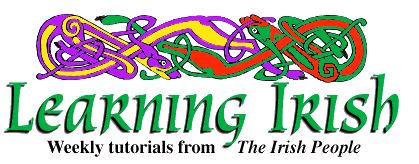
Irish Lesson 5
|
You have already noticed the frequent use of what looks like an accent mark over vowels in Irish words. The slanting line (síneadh fada (SHEEN-uh FAH-duh) or sometimes "síneadh") is not really an accent mark, however, but instead basically indicates the length of time that you pronounce the vowel. For example, the word "pósta" (POHS-tuh), meaning "married", has the same (oh) sound that is in the word "cnoc" (kuh-NOHK), meaning "hill", but for "pósta" the (oh) sound is held longer. Often a short vowel in an Irish word will sound to an American somewhat like the (uh) in "unfit". We have represented the sound by (uh) in some cases, because Americans will find the (uh) sound closer to their pronunciation experience. The Irish word "clog" is an example. We represent it by (kluhg), but as your pronunciation improves, you will learn to pronounce it with a short (oh) sound, rounding your lips more than for (uh). Irish makes less use of the (uh) sound than does English, and this is important to remember as you refine your pronunciation. The síneadh fada can indicate significant pronunciation differences. For example, "Seán" is a name, but "sean" means "old". "Fear" (far) is "man", but "féar" (fay*r) is "grass". The word "Éire" (AY-re) means "Ireland", but "eire" (E-re) is "burden". On Irish stamps a few years ago, Ireland was called "Eire", through either ignorance or malice.
Grammar
First, masculine nouns:
Next, feminine nouns: A few adjectives come before the noun. "Sean" (shan), meaning "old", is one of these. It aspirates the initial consonant of the noun. Learn these examples:
sean-bhord (shan vwohrd), an old table
Practice With this as the basic sentence, go through the progressive drill that you learned in Lesson 4, inserting these word groups for "X":
bean mhór (ban vwohr), a big woman Start with: An bhfuil bean mhór sa chistin? (un VWIL ban vwohr suh HYISH-tin) Is there a big woman in the kitchen? Níl bean mhór sa chistin. Tá an bhean bheag sa chistin. An bhfuil an bhean bheag sa chistin? And so on. The last two sentences will be: Níl do chat ramhar sa chistin. Tá bean mhór sa chistin.
Where you stand
Conversation Pádraig (PAW*-drig): Dia's Muire duit, a Bhriain (DEE-uhs MWIR-uh git, uh-VREE-in.) Conas tá tú? (KUN-uhs taw* too) Hello, Brian. How are you? Brian: Tá mé go maith (TAW* may* goh MAH). Agus conas tá tú féin? (AH-guhs KUN-uhs taw* too fay*n) I am well. And how are you yourself? Pádraig: Tá mé go maith, freisin (FRESH-in). Tá báisteach air anois (taw* BAW*SH-tuhk* er uh-NISH). I am well, too. It looks like rain now. Brian: Bhí sé ag cur báistí aréir (vee shay* uh kur BAW*SH-tee uh-RAY*R). Féach! Tá an t-sráid fluich fós (FAY*-ahk*! taw* un traw*d flyuk* fohs). It was raining last night. Look! The street is still wet. Pádraig: Tá an aimsir fuar fliuch, go cinnte (taw* un EYEM-sheer FOO-uhr flyuhk*, goh KIN-te). The weather is cold and wet, certainly. (c) 1997 The Irish People. May be reprinted with credit. |